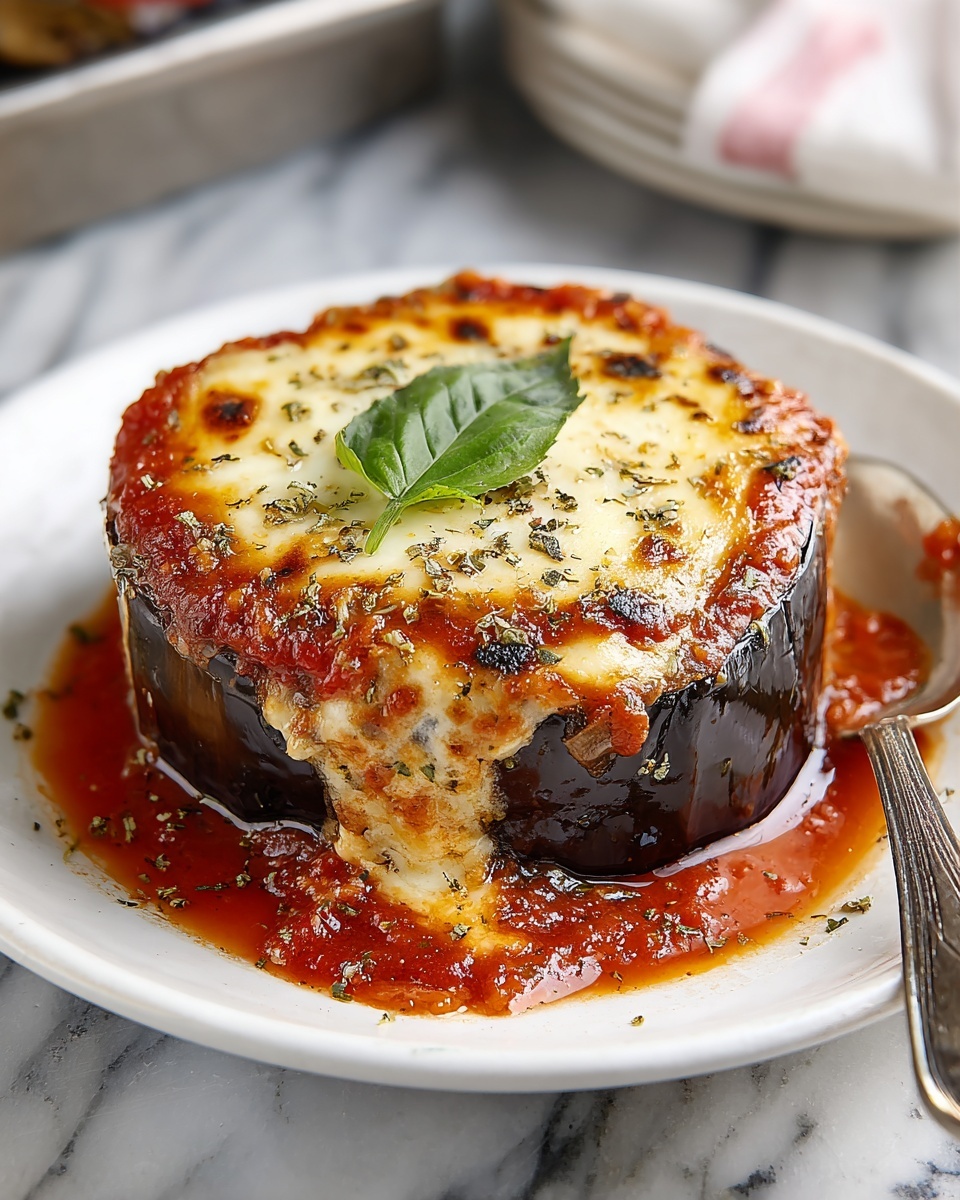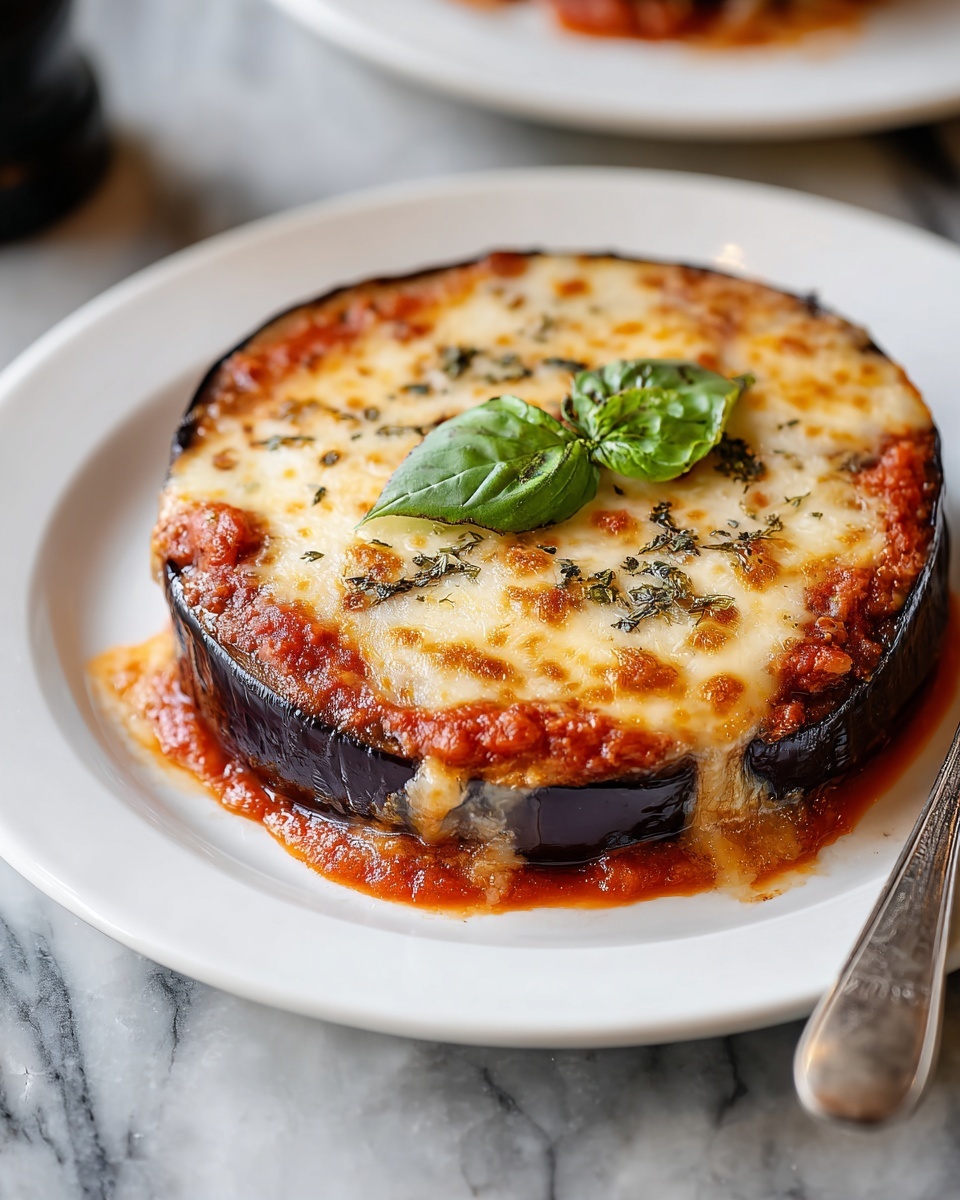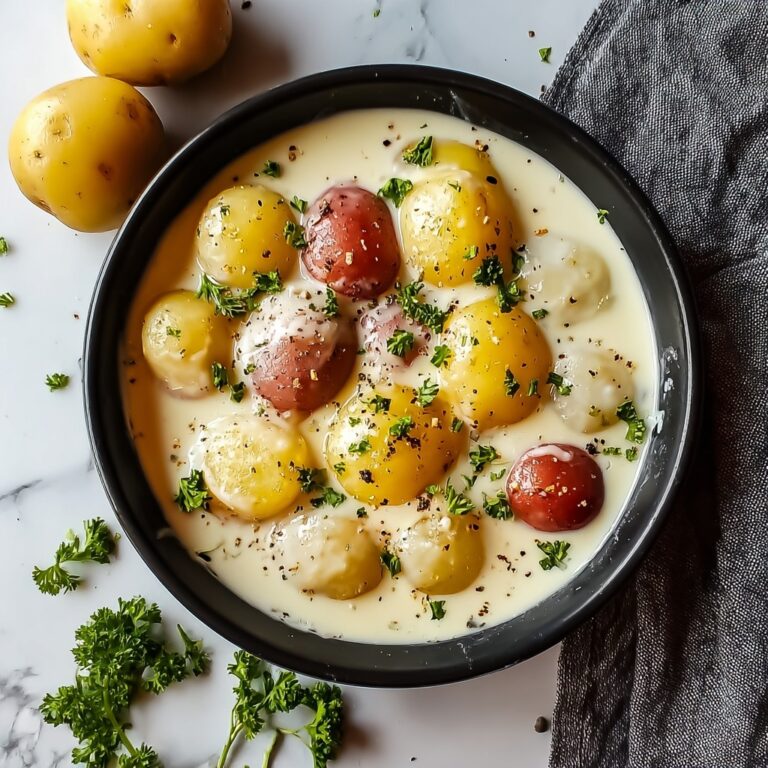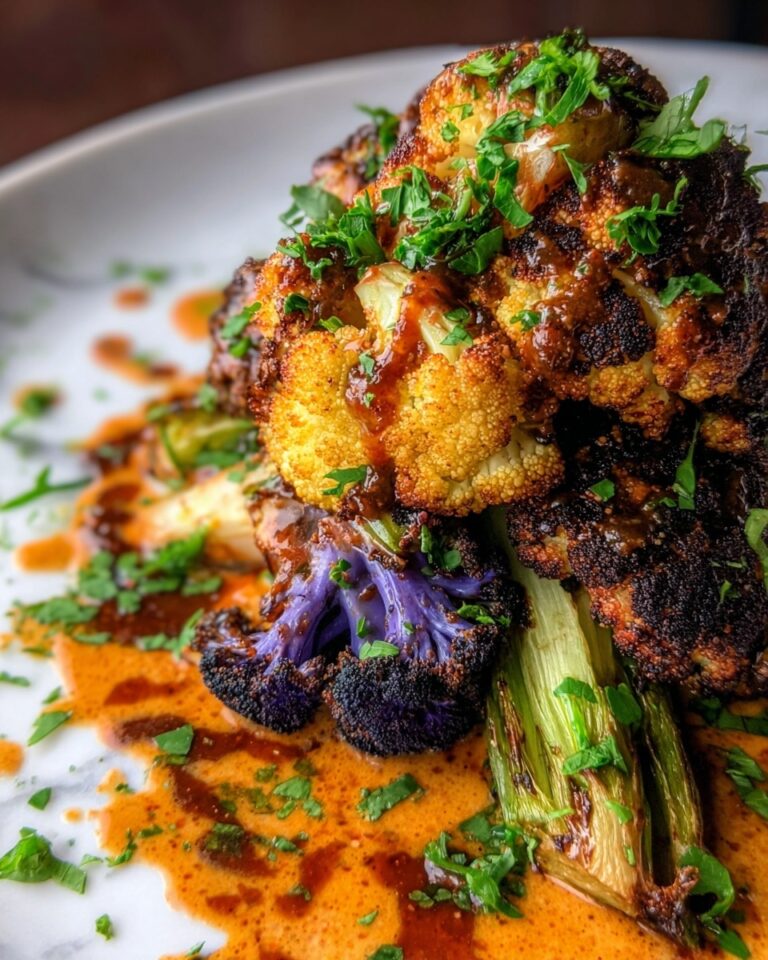If you have ever dreamed of a warm, comforting Italian classic that wraps you in layers of rich flavors and melty cheese, then the Parmigiana di Melanzane (Aubergine Parmigiana) Recipe is about to become your new favorite. This dish is a masterpiece of tender aubergine slices layered with hearty tomato sauce, fragrant basil, and indulgent cheeses, baked to a golden bubbly perfection. It’s a celebration of simple ingredients coming together to create something absolutely unforgettable and hearty enough to delight family and friends alike.

Ingredients You’ll Need
Every ingredient in this Parmigiana di Melanzane (Aubergine Parmigiana) Recipe plays a crucial role in building the perfect balance of flavors, textures, and colors. From the savory aubergines to the fresh basil and cheeses, each component is essential to making this dish sing.
- 2 large eggplants (aubergines), sliced into 1/4-inch rounds: Choosing firm, fresh aubergines ensures tender, succulent layers in the final dish.
- Salt (for salting the eggplant): Essential for drawing out excess moisture and removing any bitterness from the eggplants.
- 2 tablespoons olive oil: Adds depth and richness when sautéing the garlic and introducing the tomato sauce.
- 2 garlic cloves, minced: Brings aromatic brightness that enhances the sauce’s flavor.
- 1 (28 oz) can crushed tomatoes: Forms the luscious, tangy base for the sauce, balancing the rich cheese and eggplant layers.
- 1/2 teaspoon dried oregano: Offers a classic Mediterranean herbal note that complements both the tomatoes and cheese.
- Fresh basil leaves, torn: Added at the end of simmering for a fresh burst of herbal flavor and vibrant color.
- 1 1/2 cups shredded mozzarella cheese: Melts beautifully, creating that gooey, stretchy cheese layer everyone loves.
- 1/2 cup grated Parmesan cheese: Adds a nutty, savory punch and crisp topping when baked.
- 1/2 cup all-purpose flour (for dredging): Helps create a golden crust on the fried aubergine slices.
- Vegetable oil (for frying): Provides a neutral base for frying aubergines to golden perfection without overpowering the flavors.
- Salt and pepper, to taste: Critical seasonings to bring out all the natural tastes within the dish.
How to Make Parmigiana di Melanzane (Aubergine Parmigiana) Recipe
Step 1: Prepare the Eggplants
Start by salting the eggplant slices generously and letting them sit for 30 minutes. This simple step is key because it pulls out excess moisture and any bitterness, so your aubergines will be tender and flavorful, never soggy. Afterward, gently pat them dry to prep for frying.
Step 2: Make the Tomato Sauce
In a pan, warm the olive oil and sauté the minced garlic until fragrant, filling your kitchen with that inviting aroma. Add the crushed tomatoes and dried oregano, season with salt and pepper, then let everything simmer gently for about 20 minutes. Finish by stirring in torn fresh basil leaves for that unmistakable hint of garden freshness.
Step 3: Fry the Eggplant Slices
Lightly dredge the prepared eggplant slices in all-purpose flour to ensure they crisp up nicely in the oil. Fry them in hot vegetable oil until each slice achieves a beautiful golden brown exterior, then drain on paper towels. This step gives your Parmigiana a wonderful texture contrast between creamy inside and crisp outside.
Step 4: Assemble the Layers
Preheat your oven to 350°F (175°C). In a baking dish, start layering by spreading a spoonful of tomato sauce, then a layer of fried eggplant. Follow with mozzarella and Parmesan cheeses, repeating these layers until all the ingredients are used. Make sure the very top finishes with sauce and an extra sprinkle of cheese to get that irresistible golden crust.
Step 5: Bake to Perfection
Put your assembled Parmigiana di Melanzane (Aubergine Parmigiana) Recipe into the oven and bake for 25 to 30 minutes. The cheese will bubble and brown beautifully, inviting you to taste the rich melding of flavors. Let the dish rest for 10 minutes before serving—that way, each slice will hold its shape and flavors will settle deliciously.
How to Serve Parmigiana di Melanzane (Aubergine Parmigiana) Recipe

Garnishes
A sprinkle of fresh basil leaves and a dusting of grated Parmesan on top right before serving adds a burst of herbal freshness and a gorgeous presentation touch. Some freshly cracked black pepper also brightens the flavors with a subtle bite.
Side Dishes
This dish is a complete meal on its own but pairs beautifully with a crisp green salad, garlic bread, or a light pasta tossed with olive oil and herbs. These accompaniments balance the richness of the Parmigiana and make for a well-rounded dining experience.
Creative Ways to Present
Serve the Parmigiana di Melanzane (Aubergine Parmigiana) Recipe in individual ramekins or cut into neat squares for a buffet-style meal. Layering portions in glass dishes shows off the gorgeous color contrast, turning your meal into a visual feast as well as a taste sensation.
Make Ahead and Storage
Storing Leftovers
Leftover Parmigiana di Melanzane holds its charm well. Store it in an airtight container in the refrigerator for up to 3 days, and you’ll find the flavors deepen overnight, making for a taste that’s even more satisfying the next day.
Freezing
If you’d like to save this gem for longer, it freezes beautifully. Portion the dish into freezer-safe containers before baking or after cooling from baking. When properly wrapped, it can be frozen for up to 2 months without losing its wonderful texture.
Reheating
To reheat, thaw overnight in the fridge if frozen, then warm up in the oven at 350°F (175°C) until heated through and bubbling again. Avoid microwaving to keep that lovely crispy top and creamy interior intact.
FAQs
Can I bake the eggplant instead of frying?
Absolutely! Baking is a healthier alternative and still produces tender slices. Brush the aubergine rounds with olive oil and bake at 400°F (200°C) for about 20 minutes, flipping halfway, before layering.
What cheese can I substitute if I don’t have mozzarella?
Fresh mozzarella is preferred for its meltability, but you can use provolone or fontina as substitutes. Just keep in mind their flavors are a bit different but still delicious in this recipe.
Is Parmigiana di Melanzane gluten-free?
The original recipe uses flour for dredging, which contains gluten. You can swap it for a gluten-free flour blend or cornstarch to make it gluten-free without compromising the crust.
Can I prepare the sauce in advance?
Yes! The tomato sauce can be made a day ahead and stored in the fridge. This not only saves time on the day you assemble the dish but also allows the flavors to develop more fully.
What’s the best way to slice eggplants for this recipe?
Slice them into 1/4-inch thick rounds for perfect layering. Too thin and they won’t hold texture; too thick and they might not cook evenly. Consistency is key!
Final Thoughts
There is something truly special about the Parmigiana di Melanzane (Aubergine Parmigiana) Recipe that warms your heart with every bite. Whether you’re cooking for a cozy family dinner or impressing guests, this dish never fails to comfort and delight. Don’t hesitate to give it a try—you just might discover a new soul food favorite that brings a touch of Italy right to your kitchen table.
Print
Parmigiana di Melanzane (Aubergine Parmigiana) Recipe
- Prep Time: 30 minutes
- Cook Time: 30 minutes
- Total Time: 1 hour
- Yield: 4 to 4.5 servings
- Category: Main Course
- Method: Baking
- Cuisine: Italian
- Diet: Vegetarian
Description
Parmigiana di Melanzane, or Aubergine Parmigiana, is a classic Italian baked casserole featuring layers of fried eggplant slices, rich tomato sauce, and a blend of melted mozzarella and Parmesan cheeses. This comforting dish offers a perfect balance of savory flavors and textures, ideal for a satisfying family meal.
Ingredients
Eggplant Preparation
- 2 large eggplants (aubergines), sliced into 1/4-inch rounds
- Salt (for salting the eggplant)
Tomato Sauce
- 2 tablespoons olive oil
- 2 garlic cloves, minced
- 1 (28 oz) can crushed tomatoes
- 1/2 teaspoon dried oregano
- Fresh basil leaves, torn
- Salt and pepper, to taste
Other Ingredients
- 1 1/2 cups shredded mozzarella cheese
- 1/2 cup grated Parmesan cheese
- 1/2 cup all-purpose flour (for dredging)
- Vegetable oil (for frying)
Instructions
- Prepare the Eggplant: Sprinkle the sliced eggplants generously with salt and let them sit for 30 minutes. This process helps to draw out excess moisture and reduce any bitterness. Afterward, pat the slices dry thoroughly with paper towels to remove the moisture and excess salt.
- Make the Tomato Sauce: Heat the olive oil in a pan over medium heat. Add the minced garlic and sauté until fragrant but not browned. Pour in the crushed tomatoes, add dried oregano, and season with salt and pepper to taste. Allow the sauce to simmer gently for about 20 minutes, allowing the flavors to meld. Turn off the heat and stir in the torn fresh basil leaves for a fragrant finish.
- Fry the Eggplant: Dredge each eggplant slice lightly in all-purpose flour, shaking off any excess. Heat vegetable oil in a frying pan over medium-high heat and fry the eggplant slices until they develop a golden brown color and are tender. Remove and place on paper towels to absorb any excess oil.
- Assemble the Parmigiana: Preheat the oven to 350°F (175°C). In a baking dish, start with a layer of tomato sauce, followed by a layer of fried eggplant slices, then sprinkle with mozzarella and Parmesan cheese. Repeat these layers, finishing with a final layer of sauce topped with the remaining cheeses to ensure a cheesy golden crust.
- Bake and Serve: Place the assembled dish in the preheated oven and bake for 25 to 30 minutes, or until the cheese is bubbly and golden brown on top. Remove from the oven and let it rest for 10 minutes before serving to allow the layers to set and flavors to intensify.
Notes
- Salting the eggplants is crucial to remove bitterness and excess moisture, which helps prevent sogginess.
- Use fresh mozzarella for best melting results and flavor.
- Allow the dish to rest after baking to help it set for cleaner slicing.
- For a lighter version, eggplant can be baked or grilled instead of fried, though traditional flavor comes from frying.
- Leftovers can be refrigerated and taste even better the next day as flavors meld.








